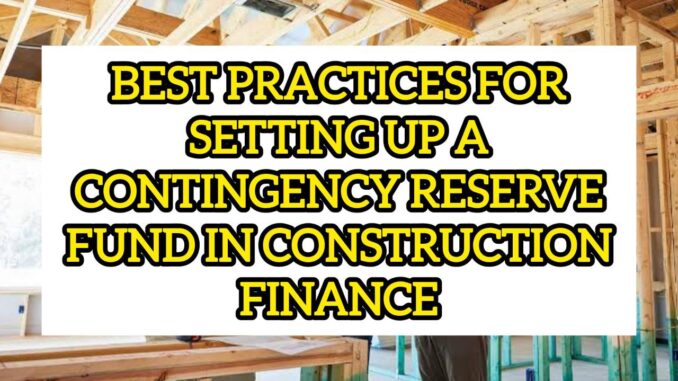
Have you ever kicked off a construction project full of excitement, only to find your budget evaporating at the first sign of unexpected soil conditions or permit delays? That’s where a contingency reserve fund comes in—your financial seat belt that keeps you secure when turbulence strikes. In the construction world, surprises aren’t a matter of “if,” they’re a matter of “when.” By establishing and managing a robust contingency reserve, you transform unknowns from budget-busting headaches into manageable bumps in the road.
What Exactly Is a Contingency Reserve Fund?
Imagine packing an extra first-aid kit on a long hike. You hope you won’t need it, but you’ll be relieved it’s there if someone twists an ankle. A contingency reserve fund serves the same purpose in construction: it’s money set aside to cover costs that traditional line items didn’t anticipate. Rather than scrambling to secure emergency funding mid-build, you draw from your reserve with clear protocols and approvals—keeping work moving smoothly.
Why Contingency Reserves Are Non-Negotiable
In construction, budgets live and die by accuracy. Even with laser-focused planning, factors like wild weather, regulatory shifts, or supplier delays can derail cost estimates. Without a contingency fund, you risk work stoppages, strained subcontractor relationships, and frantic calls to lenders or equity partners. A reserve doesn’t just cushion your budget; it safeguards your reputation and prevents projects from grinding to a halt when the unexpected hits.
Key Categories of Contingencies
Design Contingencies
Design contingencies guard against omissions or errors in the architect’s drawings. Think of these as financial cushions for scope tweaks—whether it’s adding fire-rated walls you forgot to budget or upgrading to a sturdier structural element when detailed geotech reports arrive.
Construction Contingencies
Construction contingencies absorb the costs of unforeseen site conditions—rockier soil than anticipated, hidden utility conflicts, or contractor change requests. These reserves keep crews paid and schedules on track when Mother Nature or buried pipes throw a curveball.
Management Contingencies
Management contingencies cover owner-driven changes, accelerated schedules, or market-driven price surges in materials. If you decide halfway through to enhance lobby finishes or fast-track for a VIP ribbon-cutting, management contingencies pick up the tab.
Determining the Right Contingency Percentage
You wouldn’t season a stew by pouring in half the spice jar, and you shouldn’t set your contingency by guessing. Industry norms suggest 5% to 15% of total hard costs, calibrated to project complexity. A straightforward suburban build might need 5%, while a multi-story urban development on reclaimed land could justify 12–15%. Historical data from similar projects is your best friend here—dig into past overruns to refine your percentage and avoid overly generous—or dangerously stingy—buffers.
Assessing Project Complexity and Risk
Complexity fuels uncertainty. An empty greenfield lot in the suburbs holds fewer hidden surprises than a historic downtown site slated for adaptive reuse. Scrutinize variables like soil variability, environmental remediation needs, local permitting timelines, and supply-chain volatility. The more moving parts, the larger your contingency should grow to catch whatever falls through.
Leveraging Historical Project Data
History is a powerful teacher. Triangulate data from three to five past projects—particularly those matching your build type and locale—to quantify average cost overruns. If your portfolio shows a consistent 8% overrun on similar work, use that insight to set a baseline contingency rather than relying purely on gut feel.
Integrating Stakeholder Perspectives
A contingency built in a vacuum won’t hold up under scrutiny. Bring owners, architects, contractors, and lenders into the conversation early. Collective buy-in ensures everyone agrees on the reserve’s size, draw procedures, and approval thresholds—fostering transparency and trust down the line.
Crafting a Tiered Approval Process
Without clear rules, a contingency fund can turn into a free-for-all. Establish tiered draw-down levels: small withdrawals (under $10K) require only a project manager’s sign-off, medium draws (up to $50K) need owner approval, and large reallocations demand leadership from finance committees or lender consent. This structure balances agility with accountability.
Documenting Draw-Down Procedures
Every withdrawal must be justified. Require formal change orders, detailed cost estimates, and risk assessments tied to each draw. By documenting each step—who requested funds, why, and how much—you create an audit trail that wards off disputes and keeps financial controls tight.
Mapping Contingency to Risk Registers
Don’t treat your reserve as a monolithic pool. Link portions to specific risks in your project’s risk register. For example, allocate $200K for potential geotechnical surprises, $150K for schedule acceleration needs, and $100K for design scope changes. When a risk materializes, you know exactly which bucket to tap.
Establishing Separate Accounting Codes
Maintaining separate accounting codes for contingency transactions prevents commingling with general expenses. Unique codes mean every dollar drawn is tracked, reported, and reviewed—essential for audits and clear financial reporting to stakeholders.
Monitoring Contingency Usage in Real Time
With risks crystallizing daily, passive tracking won’t suffice. Use construction management software that updates budget burn rates in real time. Dashboards that flag low reserve balances or spikes in contingency draws empower teams to take corrective action before it’s too late.
Scenario Planning and Stress Testing
What if steel prices jump 15%? Or your lead contractor goes bankrupt? Running worst-case scenarios against your contingency fund reveals exposure points. Stress tests help you judge whether your reserve is adequate or needs a top-up before such shocks strike.
Replenishing the Reserve Mid-Project
Even the best-laid plans can exhaust reserves. Arrange for top-up mechanisms at project outset—whether reallocations from soft cost savings, drawdowns on equity contributions, or tapping a dedicated line of credit. Pre-approved methods mean you can bolster your fund instantly when usage spikes unexpectedly.
Aligning Reserve Requirements with Loan Covenants
Lenders often stipulate minimum contingency levels tied to completion percentages. For instance, a lender may require a 10% reserve until 50% of work is complete, reducing to 5% thereafter. Embed these covenants in your draw schedule to avoid painful remediation discussions when you seek funding disbursements.
Communication Protocols for Contingency Status
Regular updates build stakeholder confidence. Include contingency metrics in weekly or monthly reports—starting balance, funds used, remaining budget. Visual gauges or trend graphs make the data intuitive, ensuring everyone sees the fund’s health status at a glance.
Training Teams on Contingency Governance
Policies are only effective if people follow them. Conduct workshops for project managers, accountants, and executives on your contingency framework. Simulated exercises—like mock draw requests—ensure teams know approval workflows and documentation standards before actual funds are at stake.
Linking Contingency to Key Performance Indicators
Tie reserve usage to project KPIs such as cost variance, schedule adherence, and change order frequency. Teams aware of how contingency draws affect broader metrics are more judicious in tapping the fund, cultivating a culture of disciplined financial stewardship.
Managing Hidden or Omitted Scope Discoveries
No matter how thorough your preconstruction surveys, hidden conditions can emerge—underground storage tanks, archaic utilities, or archaeological finds. A reserve earmarked for “site unknowns” empowers you to address these issues without project delays or renegotiating capital.
Value Engineering to Preserve Reserve Balance
When contingency dips dangerously low, convene a value engineering session to identify cost-effective alternatives. Swapping out premium finishes for more economical yet durable options or resequencing work to avoid overtime can conserve limited reserve dollars for truly critical surprises.
Post-Completion Contingency Release
At project close, unused reserves must be addressed. Some contracts allow the residual to revert to the owner or project sponsor; others mandate rolling funds into long-term maintenance accounts. Clarify post-completion disposition early to prevent conflicts over leftover capital.
Conducting Post-Mortem Analyses
Once the dust settles, compare planned versus actual contingency usage. Document lessons—were certain risks overestimated? Did others crop up unexpectedly? Share these insights with future project teams to refine contingency modeling and sharpen risk foresight.
Leveraging Technology Platforms
Today’s construction tech tools integrate budgeting, risk registers, and real-time draw tracking. Automated alerts notify you when contingency usage crosses thresholds, while predictive analytics can forecast depletion points based on current burn rates—putting proactive fund management at your fingertips.
Best Practices Summary Checklist
To recap, effective contingency management hinges on: defining clear categories; setting data-driven percentages; establishing robust approval workflows; mapping reserves to risks; real-time monitoring; scenario testing; proactive replenishment; alignment with lender covenants; transparent communication; team training; and post-project reviews. Following this checklist turns your contingency fund from a vague line item into a strategic nerve center for financial stability.
Conclusion
A contingency reserve fund in construction finance isn’t a luxury; it’s an imperative. By thoughtfully sizing your reserve, tying it to quantified risks, enforcing tiered approvals, and leveraging real-time monitoring, you insulate your project from the unpredictable. Discipline in drawing down, replenishing wisely, and learning from every expenditure cements contingency as a strategic asset. With these best practices, you’ll transform surprises from budget-busting emergencies into planned, manageable events—keeping your projects firmly on course, no matter what lies beneath the surface.
FAQs
How do I decide whether to allocate 5%, 10%, or 15% contingency?
Base it on project complexity, site unknowns, and historical overrun data. Simple builds may need only 5%, while high-risk urban or rehab projects could justify 12–15%.
Can contingency funds cover design scope changes requested by the owner?
Yes—if you’ve earmarked a management contingency for owner-driven changes. Make sure these are clearly defined in your budget and draw procedures.
What documentation is required to tap the contingency reserve?
You’ll need a formal change order or risk-trigger report, detailed cost estimates from subcontractors or suppliers, and sign-offs per your tiered approval model.
How often should I review and adjust my contingency estimate?
Reassess at each major design milestone, permit approval, and monthly during construction. Any scope changes or schedule shifts should trigger an immediate review.
What happens to unused contingency funds at project completion?
Disposition depends on your contract: funds may revert to the owner, be applied toward final costs, or roll into a maintenance reserve. Clarify this in your agreement to avoid disputes.

West is both an engineer and a construction manager with a solid ten-year track record in directing building projects and managing their financial aspects. Throughout his career, he has honed his skills in coordinating multidisciplinary teams, streamlining budget processes, and structuring financing plans that ensure projects are delivered on time and within financial targets.
Leave a Reply